Written by Kristen Visbal
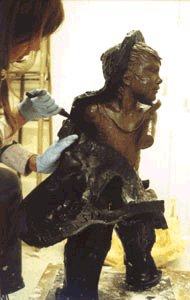 The artist gently cuts a rubber mold off the clay model. The rubber is removed and seated in the plaster shell.
The artist gently cuts a rubber mold off the clay model. The rubber is removed and seated in the plaster shell.The Lost Wax method of metal casting or cire perdue dates back over 6,000 years. Artisans of ancient Egypt, Mesopotamia, the Han Dynasty of China and the Benin civilization of Africa used this method to cast artifacts and tools. There is still debate as to who was the first to develop the technique. Without cire perdue, civilization as we know it would not exist.
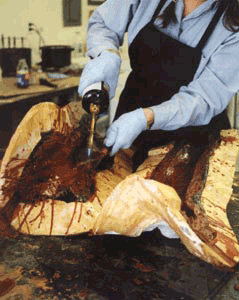 Hot wax is painted and the excess wax is trimmed before fitting the mold halves together in preparation for the final “slush” of wax.
Hot wax is painted and the excess wax is trimmed before fitting the mold halves together in preparation for the final “slush” of wax.The Lost Wax method is used extensively by sculptors all over the world. The original sculpture can be created from a variety of materials including clay, stone, wood or plasticene. Plasticene is composed of water, clay, wax and oil, and results in a superior clay that will not dry or crack and can be used repeatedly. An armature or understructure for the sculpture is created from steel, wood and wire. The clay is applied to the armature and modeled into the desired sculpture. The perfected sculpture is ready to be molded and can be cut, simplifying the form. On a figure, the head and arms may be removed and molded separately. A flexible rubber is then painted or poured on the piece, ideally 1/4 inch thick. Next, a plaster or resin shell known as the mother mold is built around the rubber to hold it’s original position. The shell is removed and the rubber is cut, gently peeled off, and returned to the mother mold. The rubber is a perfect negative of the original.
Wax casting involves painting the rubber mold with layers of hot wax. The edges of the wax are trimmed and the mold parts clamped together tightly. The mold is filled with cool wax and the excess drained. This slushing process fuses the painted layers together. Once the wax is set, the mother mold is removed and the rubber is carefully peeled away, leaving the hollow wax casting or pattern. Approximately 1/4 inch thick, the wax pattern is a hollow duplicate of the original.
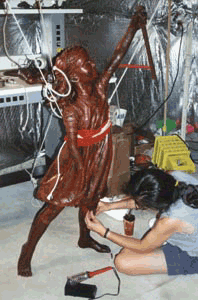 The parts of a chased wax pattern are fit together before the final “wax check”.
The parts of a chased wax pattern are fit together before the final “wax check”.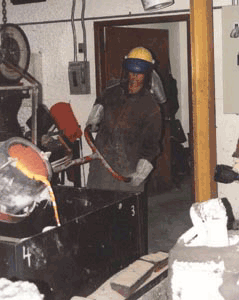 The artist pours molten bronze into a silica mold sunk into a sandbed.
The artist pours molten bronze into a silica mold sunk into a sandbed.The pattern is chased, correcting imperfections in the wax using wood and steel tools. Wax chasing is important since the metal casting will be an exact duplicate of the wax sculpture. A plumbing or sprueing system is attached to the wax sculpture using tubes or bars of wax through which metal will flow to the entire wax pattern. The piece must be analyzed for complexity and detail and a firm understanding of how molten metal flows and cools is crucial to avoid casting defects.
A colloidal silica mold or ceramic shell is built around the wax pattern in layers. This mold, unlike the rubber, can withstand the heat of molten metal. The wax sculpture and attached sprueing system are dipped in a thick batter, or slurry, and then dipped in sand. Each layer must dry four hours, building a shell that is approximately 1/2 inch thick. Holes are drilled in the sprueing system and the shell is fired in a kiln. The wax melts out through the holes, leaving a negative space into which the metal will flow; hence, the term Lost Wax. The drilled holes are patched and the molten metal poured into the mold. Bronze is poured at a temperature between 1,900 and 2,300 degrees Fahrenheit. After pouring, and the metal has solidified, the ceramic shell is water blasted or chipped off the metal and the sprueing system removed.
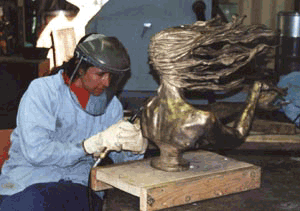 The artist metal chasing Windswept.
The artist metal chasing Windswept.Finishing the sculpture involves fitting and welding the pieces together, and recreating the original texture where welds or repairs were made. Today, pneumatic tools with small burr attachments are often used to create texture. The metal chasing stage may involve many hours of labor.
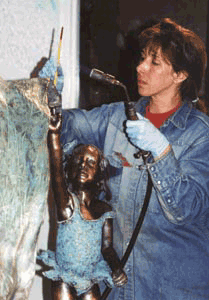 The artist applying a chemical patina to a hot surface on Children of the Sea.
The artist applying a chemical patina to a hot surface on Children of the Sea.The chased sculpture is blasted with sand or glass beads to clean the metal and create a surface tooth for chemical patination. Chemicals may be applied hot or cold and react with the metal for a variety of brilliant hues. The sculpture is coated with wax and buffed to a lustrous finish.
The Lost Wax casting process is extremely labor intensive and it may take up to 500 hours to complete a life size figure. Artisans must have a thorough understanding of the process and an adequate level of skill must be mastered at each stage. The result is an heirloom that will withstand time and the elements for thousands of years to come. The permanence and richness of bronze, as well as the sculptural possibilities it provides, make this particular metal one of the finest mediums available to sculptors and knowledgeable art collectors today.




